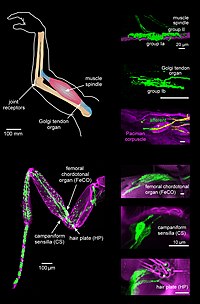
Photo from wikipedia
The purpose of this study was to profile and compare the bar dip’s kinematics and muscle activation patterns in non-fatigued and fatigued conditions. Fifteen healthy males completed one set of… Click to show full abstract
The purpose of this study was to profile and compare the bar dip’s kinematics and muscle activation patterns in non-fatigued and fatigued conditions. Fifteen healthy males completed one set of bar dips to exhaustion. Upper limb and trunk kinematics, using 3D motion capture, and muscle activation intensities of nine muscles, using surface electromyography, were recorded. The average kinematics and muscle activations of repetitions 2–4 were considered the non-fatigued condition, and the average of the final three repetitions was considered the fatigued condition. Paired t-tests were used to compare kinematics and muscle activation between conditions. Fatigue caused a significant increase in repetition duration (p < 0.001) and shifted the bottom position to a significantly earlier percentage of the repetition (p < 0.001). There were no significant changes in the peak joint angles measured. However, there were significant changes in body position at the top of the movement. Fatigue also caused an increase in peak activation amplitude in two agonist muscles (pectoralis major [p < 0.001], triceps brachii [p < 0.001]), and three stabilizer muscles. For practitioners prescribing the bar dip, fatigue did not cause drastic alterations in movement technique and appears to target pectoralis major and triceps brachii effectively.
Journal Title: International Journal of Environmental Research and Public Health
Year Published: 2022
Link to full text (if available)
Share on Social Media: Sign Up to like & get
recommendations!